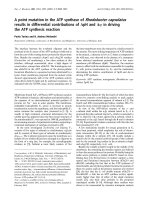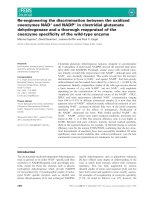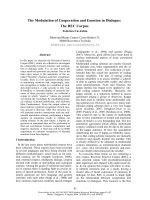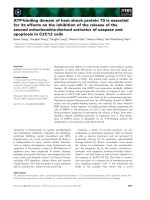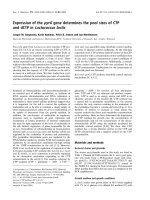Assessment of the diversity of reptile and amphibian in cat ba national park hai phong vietnam
Bạn đang xem bản rút gọn của tài liệu. Xem và tải ngay bản đầy đủ của tài liệu tại đây (7.87 MB, 61 trang )
(al, 2011)
MINISTRY OF AGRICULTURE AND RURAL DEVELOPMENT
VIETNAM NATIONAL UNIVERSITY OF FORESTRY
STUDENT THESIS
ASSESSMENT OF THE DIVERSITY OF
REPTILE AND AMPHIBIAN
IN CAT BA NATIONAL PARK, HAI PHONG, VIETNAM
Major: Natural Resources Management (Advanced Curriculum)
Code: D850101
Faculty: Forest Resources and Environmental Management
Advanced Education Program
Developed in Collaboration with Colorado State University, USA
Student: Le Viet
Student ID: 1253060857
Class: K57-Natural Resources Management
Course: 2012 – 2016
Supervisor: Dr. Dong Thanh Hai
Hanoi, October 2016
1
ACKNOWLEDGEMENT
This thesis cannot become a reality without kind support and helps of many
individuals, I would like to extend my sincere thanks to:
The heads of Vietnam National University of Forestry, Faculty of Forest Resources
and Environmental Management provided opportunity, essential conditions for me to finish
this research.
I am grateful to my supervisor, Dr. Dong Thanh Hai, whose expertise, understanding,
generous guidance and continuous support made it possible for me to work on a topic that I
chose. It was my pleasure being his student. I would like to express my gratitude to Prof. Lee
MacDonald for spending the time to check and give advises to my proposal.
I would like to express the deepest appreciation to the heads, officers of Cat Ba
National park, local people there for providing me useful information and kind consideration
and help.
Despite spending the best efforts in the thesis conducting process, this research still
has many shortcomings due to the limitations of time, finance and my ability. I am looking
forward to receiving comments from teachers, friends to a better thesis completion.
Thank you!
Hanoi, September 2016
2
ABSTRACT
This study was conducted to provide the checklist of species of reptiles and
amphibians in Cat Ba National Park, Haiphong, Vietnam as well as the distribution, the
diversity of them in such habitats as artificial forest, natural forest, Mixed area of artificial
forest and natural forest, shrub grassland. A total of 80 species of reptile and amphibian was
recoreded within survey during July 2016 in study site: 55 species of reptile and 25 species of
amphibian. Three main methods that were used for collecting data are interview, line transect
survey, pitfall-trap. The basic data analysis indicated that reptiles and amphibians, an
important part of wildlife in Cat Ba National Park, are bringing up a lot of values to people
like food, medical values...Therefore, they have been hunted for different personal purposes in
many various ways, especially hunting. Furthermore, the living habitat of reptiles and
amphibians in Cat Ba National Park also have been threatened by 3 main threats: Pet trade
and overexploitation; Habitat loss and fragmentation; Environment pollution.. Thence, it is
very necessary to find the solutions out in order to solve these problems. The study have
recommended solutions in terms of minimizing the threats,
managing, protecting and
developing the sources of reptiles and amphibians in Cat Ba National Park more effectively
and sustainability.
3
TABLE OF CONTENTS
ACNOWLEDGEMENT
ABSTRACT
TABLE OF CONTENTS
LIST OF TABLES
LIST OF FIGURES
ABBREVIATION
CHAPTER 1. INTRODUCTION ............................................................................................... 1
CHAPTER 2. GOAL AND OBJECTIVES ................................................................................ 4
2.1. Goal ..................................................................................................................................... 4
2.2. Objectives ............................................................................................................................ 4
CHAPTER 3. STUDY SITE ...................................................................................................... 5
3.1. Geo-location ........................................................................................................................ 5
3.2. Climate and hydrology ........................................................................................................ 5
3.3. Topography.......................................................................................................................... 5
3.4. Geology and geomorphology .............................................................................................. 6
3.4.1. Geologic characteristics.................................................................................................... 6
3.4.2. Soils .................................................................................................................................. 6
3.5. Fauna and Flora ................................................................................................................... 6
3.5.1. Fauna ................................................................................................................................ 6
3.5.2. Flora .................................................................................................................................. 7
3.6. Economy-Society ................................................................................................................ 7
3.6.1. Population and employ ..................................................................................................... 7
3.6.2. Livelihood ......................................................................................................................... 8
CHAPTER 4. METHODS ........................................................................................................ 10
4
4.1. Secondary document.......................................................................................................... 10
4.2. Collecting data methods .................................................................................................... 10
4.2.1. Interview method ............................................................................................................ 10
4.2.2. Line transect survey ........................................................................................................ 11
4.2.3. Pitfall-Trap ..................................................................................................................... 13
4.3. Data analysis ...................................................................................................................... 13
CHAPTER 5. RESULTS AND DISCUSSION........................................................................ 15
5.1. The composition of reptile and amphibian in Cat Ba National Park ................................. 15
5.1.1. The results of investigation............................................................................................. 15
5.1.2. Assessment of taxon diversity ........................................................................................ 17
5.2. The distribution of reptiles and amphibians by habitats .................................................... 18
5.3. Conservation value of reptiles and amphibians ................................................................. 22
5.4. Threats to reptiles and amphibians at Cat Ba National Park ............................................. 23
5.4.1. Pet trade and overexploitation ........................................................................................ 23
5.4.2. Habitat loss and fragmentation ....................................................................................... 24
5.4.3. Environment pollution .................................................................................................... 25
5.4.4. Threats ranking ............................................................................................................... 26
5.6. Proposing solutions for protection and sustainable development of reptile and amphibian
resources in Cat Ba NP ............................................................................................................. 26
5.6.1. Solution to minimize threats to reptile and amphibian ................................................... 26
5.6.2. Solutions for technique ................................................................................................... 27
5.6.3. Solutions for socio-economic ......................................................................................... 28
CHAPTER 6. CONCLUSION, CONSTRANTS AND RECOMMENDATION .................... 29
6.1. Conclusion ......................................................................................................................... 29
6.1.1. Species composition ....................................................................................................... 29
5
6.1.2. Species distribution ........................................................................................................ 29
6.1.3. Conservation value of reptiles and amphibians in Cat Ba National Park ....................... 29
6.1.4. Threats to reptiles and amphibians ................................................................................. 29
6.1.5. Proposing solutions for protection and sustainable development of reptile and
amphibian resources in Cat Ba NP ........................................................................................... 29
6.2. Constrants .......................................................................................................................... 30
6.3. Recommendation ............................................................................................................... 30
REFERENCES
6
LIST OF TABLES
Table 5.1. Species diversity of reptile and amphibian in Cat Ba National Park ...................... 15
Table 5.2. The diversity of reptiles and amphibians species by habitats.................................. 20
Table 5.3. Conservation value of reptiles and amphibians ....................................................... 22
Table 5.4. Rank of threats to reptile and amphibian resource in Cat Ba NP ............................ 26
7
LIST OF FIGURES
Figure 4.1. Line transects for collecting data in Cat Ba National Park .................................... 12
Figure 5.1. Reptile and amphibian species recorded from sources of information in Cat Ba
National Park ............................................................................................................................ 16
Figure 5.2. The diversity of reptiles in Cat Ba National Park .................................................. 17
Figure 5.3. The diversity of amphibians in Cat Ba National Park ........................................... 18
Figure 5.4. The number of species detected in each habitat ..................................................... 19
Figure 5.5. Hunter with equipments they use for hunting reptile and amphibian (Source: Le
Viet, 2016) ................................................................................................................................ 24
Figure 5.6. Wastes the tourist put into forest (Source: Le Viet, 2016)..................................... 25
8
ABBREVIATION
NP: National Park
IUCN: The International Union for Conservation of Nature
CITES: Convention on International Trade in Endangered Species
NTFP: Non-timber Forest Product
9
CHAPTER 1
INTRODUCTION
Vietnam has an abundant of animal resources with high endemism. This is a big
advantage in strategies of protecting and developing biodiversity in our country. This resource
brought us benefit in many aspects of live. Previously, rainforest wildlife are one supply of
food and rare pharmaceuticals. Besides, many products from wildlife animal were used to
produce craft items which are very popular. Another important role of wildlife is in science
and medicine. Some animals are extremely rare resources in understanding the principles,
biomechanics, physiology to serve the prevention and medical care for people. Wildlife
animal resources, especially gene bank is very precious, is the origin of current domestic
animals, along with the balancing factor of current ecosystem.
Reptile and amphibian are other valuable resources beside birds, mammals and fishes.
In natural ecosystem as well as humanity ecosystem of our nation, reptile and amphibian play
an important role in social.
A serious problem now is the wildlife animal sources in general and the reptiles,
resources in particular are endangered of decreasing sharply. A lot of species are becoming
rarely, or special rarely, some species are threatened of becoming extincted. The main reason
that leads to this situation is the over-exploited that made the area of forest soil decrease and
some species are lost their habitat. The illegal hunting with the inefficient management of
functional agencies also need to be cared and adjusted.
Red data list is the inventory of the global conservation status of all biological species,
which is abbreviated to IUCN ( International Union for Conservation of Nature and Natural
Resources). The levels of extinction risk in Vietnam red data book are similar to those in
IUCN Red list. Up to now, the list has evaluated over 79,800 species that may come to
extinction according to categories.
1
The latest released list in 2007 shows that there are 418 endangered species of animals
according to risks of extinction. The number consists of 40 of reptiles and 13 of amphibians
(Vietnam Data Red Book, 2007).
CITES is The Convention on International Trade in endangered species of wild fauna
and flora is a multilateral treaty to ensure that international trade in specimens of wild animals
and plants does not threaten the survival of the species in the wild. CITES contains 5,000
animal species and 25,000 plant species, and is divided into 3 appendices I, II, III with
different levels of being threatened to existence species.
The decree No. 32/2006/ND-CP dated 30/03/2006 is a government decree on
Management of endangered, precious, and rare species of wild plants and animals. It has
classified wild, precious and rare animals into 2 groups according to the risk of extinction and
the protection of law towards these species. The two groups are: Group IB (Prohibiting
exploitation and use for commercial purposes, including wild plants, animals, for which
populations are very small in the wild or are in high risk of extinction) and Group IIB
(Restricting exploitation and use for commercial purposes, including wild plants and animals,
for which populations are small in the wild or are in risk of extinction). Group IB includes 62
species. Of them, there are 11 species belong to class of reptilia such as Desert Cobra
(Ophiophagus hannah...Group IIB includes 89 species and of which are such reptile species
as Indian Rock Python, Radiated Ratsnakes, etc.
In the past two decades, several herpetological surveys have been carried out on Cat
Ba Island. In his zoological analysis, Bobrov (1993) recorded 18 lizard species from islands in
the Gulf of Tonkin including Cat Ba Island. Darevsky (1990) studied the herpetofauna of
some Vietnamese offshore islands and listed seven species of reptiles for Cat Ba. This number
was distinctly increased by the eight-day survey conducted by Nguyen & Shim (1997), who
reported of 20 species of reptiles including two species of marine turtles. In view of this
2
increasing number of new species records on the one hand, and a still low species number
compared with northern mainland Vietnam on the other, we decided to conduct additional
herpetological field studies on Cat Ba Island. These led to the discovery of new species of
Goniurosaurus (Ziegler et al. 2008) and Sphenomorphus (Nguyen et al. 2011).
To protect and develop this valuable natural resources, the Government in recently
have had many optimistic policy and solutions. Beside the legislations, we also have special
use forest system
are managed by local to center and have got positive results. To make
basis , materials for natural resources preservation , contribute to protection and development
of
wildlife animals in general
and reptiles, amphibians resources in particular, I am
proceeding to research the topic " The Diversity of Reptiles and Amphibians in Cat Ba
National Park, Haiphong, Vietnam".
Results collected from this study will be used for planning and preparing technical
measures to manage, protect and develop the biodiversity effectively.
3
CHAPTER 2
GOAL AND OBJECTIVES
2.1. Goal
- The goal of this study is to investigate the diversity of Reptile and Amphibian. The
results gathered will be used for developing Reptile and Amphibian database and contributing
to biodiversity conservation in general in Cat Ba National Park
2.2. Objectives
- To study species composition diversity of reptiles and amphibians in Cat Ba National Park.
-To study the distribution of reptiles and amphibians by habitat in Cat Ba NP.
- To assess the conservation value of reptiles and amphibians in Cat Ba NP.
-To assess threats to reptiles and amphibians in Cat Ba NP.
-To give solutions for management, conservations and sustainable development of
reptiles and amphibians in Cat Ba NP.
4
CHAPTER 3
STUDY SITE
3.1. Geo-location
- Cat Ba National Park was founded in 1986 and located in Cat Ba island, Cat Hai district
- The geographical coordinates:
From 20043 '50" to 20051' 29" north latitude
From 106058 '20" to 107010' 05" east longitude
- Area: 16,196.8 ha of which mountain is 10,931.7 ha and island is 5,265.1 ha
- Cat Ba National Park is first park that have subzones of forest and marine ecosystem
- Cat Ba National Park is divided into three functional areas: the subdivision of strict
protection zone (4,914.6ha), the subdivision of ecological rehabilitation area (11,094ha),
service administrative subdivision (91.3ha).
3.2. Climate and hydrology
Cat Ba National Park is located in the tropical monsoon area, influenced many of the
coastal line climate - Average annual temperature: 20oC; Average annual precipitation is:
1700 - 1800mm. Rainy season from April to November and dry season from December to
March next year; Average annual humidity is 85%; April is wettest and January is driest;
Average annual evaporation is 700mm per year; monsoon northeast wind from September to
March next year, the southeast wind from April to August; an average of 2-3 storm a year.
3.3. Topography
All of Cat Ba island are mountainous areas with elevations between 50-200m, the
average slope is 30-40 degrees; the lowest place is Ang Tom, 10-30m below sea-level; the
highest place is Cao Vong peak located in the north of the island, about 331m high. Main
terrain of Cat Ba is limestone alternating with many large and small valleys. In terms of
mineral resources, in addition to limestone, Cat Ba Island also has valuable mineral water
(Xuan Dam commune has hot mineral water mine with temperature of 38oC). Cat Ba’s typical
5
ecosystems are tropical rain forests on limestone mountains. mangroves, coral reefs, sea grass,
cave ecosystem, etc.
3.4. Geology and geomorphology
3.4.1. Geologic characteristics
- Cat Ba area as well as the Northeast Vietnam has a history of lasting geological
development, had been a part of the folded structure Caledonia marks the end geosynclinals
regime deep sea Karatzia in late Silurian.
- The limestone blocks with an average age of carbon Late - Permian (250-280 million
years). There is configuration blocks, sometimes stratified pretty thin, gray or white-gray
alternating with silicon limestone. They are full shape of a Karst domain submerged of sea,
due to the impact of surface water and groundwater has created a system of caves in different
heights (4 meters, 15 meters and 25-30 meters). Due to the activities of the ocean waves has
created waves in all limestone foot of Cat Ba Island and the porches abrasive long shape and
narrow surrounded, with the dual wave at 3.5-4.0 meters and 1.0-1.5 meters.
3.4.2. Soils
- Survey results field work, mapping land II, shows the internal and external
communal of Cat Ba National Park because bedrocks mostly limestone with Karst topography
conditions and humid tropical climate, so have formed the main soil types are as Red-brown
soil Feralit developed on limestone (Fv); Soil Feralit sepia slopes capacitors of the foot of a
mountain limestone (Tv); Soil Feralit fawn develop from the product of weathered limestone
mixed (Th); Alluvial sour salt (Db) .
3.5. Fauna and Flora
3.5.1. Fauna
- Cat Ba Island has 53 animal species belonging to 18 families with 8 of ordo; 160
species of birds with 46 families belonging to 16 orders; 46 reptile species with 16 families
belonging to 2 orders; 21 species of amphibians with 5 families belonging to 1 order.
6
-Terrestrial animals about 282 species, especially species of golden langur
(Trachypithecus poliocephalus), this is beasts species particularly rare in the world only
remains in Vietnam (about 50-60 individuals, according to the IUCN Red List).
- Marine animals: there are 98 species of zooplankton, 196 species of marine fish
(including 79 species of reef fish), 177 species of coral, 532 species of bottom animals.
According to survey data of the Institute of Oceanography in Hai Phong, said today there are
900 fish species, 500 species of molluscs, 400 species of crustaceans. In total number of marine
species in the area of Cat Ba has found there are 21 rare species, including two species listed in
the CITES list, 7 species in the Vietnam Red Book need protected still exist in the region.
3.5.2. Flora
- Flora resources on Cat Ba island abundant with statistics of 620 species belonging to
438 genera and 123 families. The typical family: Myrtaceae, Moraceae, Rubiaceae,
Lauraceae, Asteraceae.
-Plant composition in Cat Ba not really abundant, but still much value crops
economically and science as: Fagraea fragrans, Chukrasia velutina, Aglaia spectabilis,
Podocarpus fleuryi. The most typical of the type of vegetation in Cat Ba Island is the type of
evergreen rain moist forest on limestone, and mangroves forest vegetation type coastal,
estuaries. Additionally, in areas still appear some specific forest types and rare, it is kind of
submerged vegetation in high mountains.
- In addition to the forest vegetation, agricultural vegetation type also plays a key role in the
region. This vegetation including: plantation forests, perennials, agricultural crops, fruits,
aquaculture and residential areas.
3.6. Economy-Society
3.6.1. Population and employ
- According to statistics in 1997, the Cat Ba district population is 27,051 people,
accounting 1.6% of the total population of the city of Hai Phong. The average population
density of the district is 80 people/km2.
7
- The number of people in labor age is 10,500 people (1997), 12,000 (2000) and
15,000 people (2010).
- According to the Statistical Office of Hai Phong city, population increase in the area
of Cat Ba Island mainly is natural increase with an average of 0.68%/year (2011), lower than
the annual average rate of Hai Phong city and the country. Relatively stable population in
recent years, the phenomenon of migration freely to the island. Total population of the region
as of 2011 was 16,566 people, the proportion of men and women in the past years without
significant changes, the percentage of women than men usually a little higher. According to
statistics in 2011, the percentage of women in the region accounted for 50.69%.
3.6.2. Livelihood
3.6.2.1. Production of industrial and handicraft
- The small engineering works, repairing boats, stone production, mineral water,
production of building materials, electricity, rapidly developing produce timely service and
create Occupations for thousands of workers.
- In general, industry and handicraft development less powerful, scattered and focused
in town.
3.6.2.2. Agricultural production
- Cat Ba island is limestone terrain, so largely lacks surface water. The commune on
the island with an area not exceeding 200 ha of agricultural land. The rice output is not high,
so do not meet people's demand for agricultural communes as well as people on the island.
Agricultural production sector accounts a very small proportion of the economy of the
district (all district only occupy 1.5% of the total production value and 2.3% of GDP in the district).
3.6.2.3. Economic forest
- Due to the forests area on the island of Cat Ba majority belonging to management
area of the national park management board, so the area of forest land in the area of the buffer
8
zone is not much. So far, FPU of district was coordination with FPU of national park guided
perform some work such as: reforestation focus, scattered plantations, restored forests and
forest care. Cat Ba island has a forest area of 15,200ha, of which forest land managed by the
National Park is 9,800 ha, remaining 6,400 ha is managed by the cooperative. Natural wood
forest has about 293 ha (shrubs forest). Plantations: resinous pine (126 ha), Acacia (66 ha),
Cunminghamia lanceolata (30 ha), Bamboo (40 ha).
3.6.2.4. Fishery Exploitation
- Cat Hai district has 288 fishing ships with a total capacity of 3120 CV, exploitation
output 3,944.7 tons of shrimp, fish of all kinds (2011). For offshore fishing ships, fishing
grounds mainly are offshore region.
9
CHAPTER 4
METHODS
This study was conducted between January and August, 2016. The thesis proposal
was written up from January to June as well as preparing equipment, knowledge, document
for collecting data in the field. In the period of July, 5th and 22th, the field work (collecting
data) had been running. Then, this study have analyzed data and finished in September, 2016.
4.1. Secondary document
- Before go collecting data, the author did write thesis proposal, learn about study site
through documents, previous researchs that related to infomations of study site and reptilesamphibians such as natural conditions, maps, lists of reptiles-amphibians have published...
4.2. Collecting data methods
4.2.1. Interview method
Before going to interview, it is very necessary to prepare things following:
- Questionaires
- Pen, notebook, recorder,...
4.2.1.1. Interview the rangers and Cat Ba NP staff
This study had interviewed 5 rangers and 3 staffs of Cat Ba NP.
- Goal: To collect the information about the sources of reptiles and amphibians, where
they appear mostly, when they appear mostly, the status of hunting rare reptiles and amphibians.
- Objects: officials working for conservation projects, scientific department, rangers of
Cat Ba National Park.
- Content: The interviewee would be asked with prepared questions that related to the
status of reptiles and amphibians, threats to their lives...
4.2.1.2. Interview the hunters and local people
The study had interviewed a total of 15 people including 4 hunters and 11 local people.
10
- Goal: To collect the information about the species they meet daily as well as the time
and location; How they catch reptiles-amphibians and what they catch for.
- Objects: Local people and hunters randomly in line transect.
- Content: The interviewee would be asked with prepared questionaire that related to
the reptile and amphibian species they meet; do they catch or not and for what; the price of
reptiles and amphibians catched for sale...
4.2.2. Line transect survey
4.2.2.1. Preparation
Transects establishment principles:
- Designing transects spend the priority on where are easy to be recognized and
approached such as path, areas that have high humidity or streams.
- The length of transects from 2 to 3 kilometers, the distance between transects is 500m up
to types of habitats and terrain, the distance from transects to road must be 25m at least.
- The transects are created based on topographic map, vegetation and actual experiment.
- The transects must include the typical and various habitats, topographic types of
study site. Each transect is marked by trees or others.
According to principles above, in this study, researcher created 4 transects through 4
main habitats: Artificial forest; Natural forest; Mixed area of artificial and natural forest;
Shrub grassland.
11
Figure 4.1. Line transects for collecting data in Cat Ba National Park
4.2.2.2. Performance
- The investigation was carried out on schedule as the timetable above. The researcher
started at beginning point and moved with speed of 1-2 km/h. During moving, pay attention
to look and hear sounds of reptiles and amphibians very carefully.
- The investigation time was divided into 3 periods of day: 8h-11h, 13h-17h and 19h23h (use flashlight) to determine the appearance of reptiles and amphibians in various times
of day and which period they appear the most.
- If detect an individual, the researcher would use the bat or hand (up to specific
species) to catch and put into bag. Note: just take only 1 specimen respresenting for 1 species
to record the info as aspect, size...
- To preserve the specimen, put the trapped species into 90o alcohol. Especially, with
big individual, need to operate and take off all their viscera then wash by water and alcohol.
Then put into 90o alcohol.
12
4.2.3. Pitfall-Trap
4.2.3.1. Preparation
To do this method, the researcher did had to prepare some tools and equipments like:
- Buckets with radius of 15-20cm and the 40cm depth
- Nylon, plastic barrier, GPS
- Fastener
- Hoe and spade
4.2.3.2. Performance
- The pitfall-trap is set up at 4 different habitats of artificial forest, natural forest, mixed
area of artificial and natural forest, shrub grassland. At each habitat, choose the place where is wet
and near the stream, because reptiles and amphibians tend to move to these regions.
- Buckets would be buried under the ground with top edge are parallel with the ground
surface. The distance between the traps is 1-2m and traps are connected by a plastic barrier.
Traps are set at lot of different habitats, the distance between them is 50-100m. Note: Have to
create habitat for reptiles and amphibians by putting water and dry leaves into bucket
avoiding that they may jump out.
- Check out the traps everyday to avoid that species could be trapped and died.
- When taking the animals out of the trap, use iron pair (or gloves) to pull lumbar of
the species and take them out very carefully and slowly, then specimens preserved in alcohol
90o, put on the storage awaiting classification, accreditation. While the specimens are alive,
researcher can take photo using as documents.
4.3. Data analysis
- To analyze the raw data, this study have used some software such as Microsoft-excel,
Microsoft-Word, Arc-gis, Google earth...for making table; drawing maps, chart...
- Use list of endangered species like IUCN, Vietnam Redbook, Decree 32NĐ-CP in
order to indentify conservation value of species.
13
- Use the terms of Threat Reduction Assessment for Conservation to rank the threats to
reptile and amphibians in Cat Ba NationalParrk. In order to do that, the study follow these
steps below:
Step 1: Define the project area in space and time
Step 2: Develop a list of all threats
Step 3: Define the threats and what 100% reduction means for each
Step 4: Rank each threat for area
Step 5: Rank each threat for Intensity
Step 6: Rank each threat for Urgency
Step 7: Add up the ranking scores
- This study have listed 3 main threats to reptile and amphibian in Cat Ba NP: Pet
trade and overexploitation; Habitat loss and fragmentation; Environment pollution.
14
CHAPTER 5
RESULTS AND DISCUSSION
5.1. The composition of reptile and amphibian in Cat Ba National Park
5.1.1. The results of investigation
Based on data collected from such sources as interview, line transect survey, pitfalltrap, observation in both field and specimen room, the checklist of species composition have
been recorded 80 species of reptile and amphibian belonging to 21 families and 3 orders in
Cat Ba National Park. The detailed results of reptile and amphibian species were shown in the
Appendix 5 and summaraize in table 5.1.
Table 5.1. Species diversity of reptile and amphibian in Cat Ba National Park
Order
Family
Vietnamese
name
No.
Number of
species
Specific name
Reptiles
Họ tắc kè
Gekkonida
5
2
Họ nhơng
Agamidae
4
3
Họ thằn lằn
Scincidae
8
Dibamidae
1
Lacertidae
1
1
Bộ có vảy (Squamata)
bóng
4
Họ thằn lằn
giun
5
Họ thằn lằn
thực
6
Họ kỳ đà
Varanidae
1
7
Họ rắn giun
Typhlopidae
1
8
Họ trăn
Boidae
1
9
Họ rắn hổ
Elapidae
5
10
Họ rắn nước
Colubridae
19
11
Họ rắn lục
Viperidae
5
12
Họ rắn biển
Hydrophiidae
2
15
13
Bộ rùa
Họ rùa đầm
Geoemydidae
1
14
(TESTUDINATA)
Họ vích
Cheloniidae
1
Họ cóc bùn
Pelobatidae
1
16
Họ cóc
Bufonidae
3
17
Họ nhái bén
Hylidae
3
18
Họ ếch nhái
Ranidae
5
19
Họ ếch đồng
Dicroglossidae
6
20
Họ ếch cây
Rhacophoridae
1
21
Họ nhái bầu
Microhylidae
6
Total
21
Amphibian
15
Bộ không đuôi
(Anura)
80
As shown in Table 5.1 and appendix, a total of 80 species of both reptile and
amphibian has been recorded that include 27 species (33.75%) are observed directly during
walks along the transects ; 10 (12.5%) species trapped by pitfall-traps; 80 (100%) species
recorded by observation, documents, even interviewing. There is no new species discovered.
Figure 5.1. Reptile and amphibian species recorded from sources of information in Cat
Ba National Park
16


